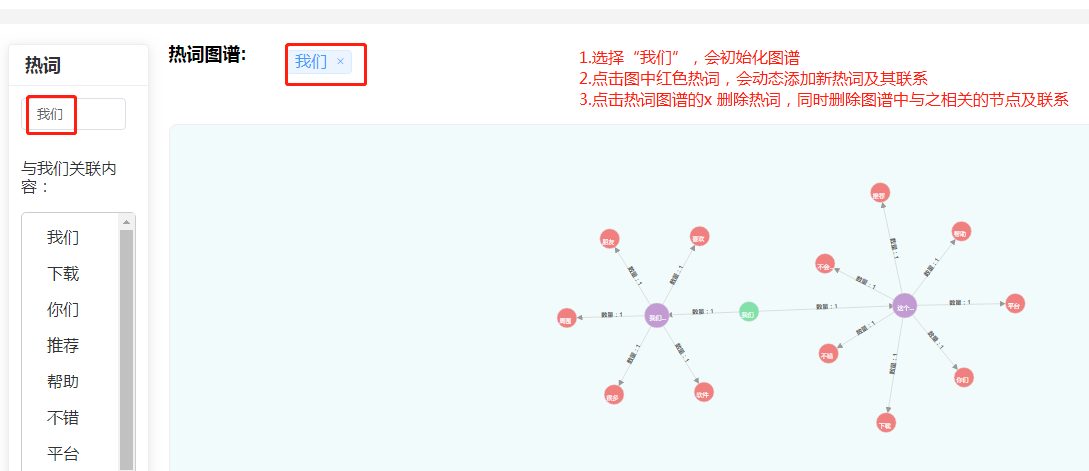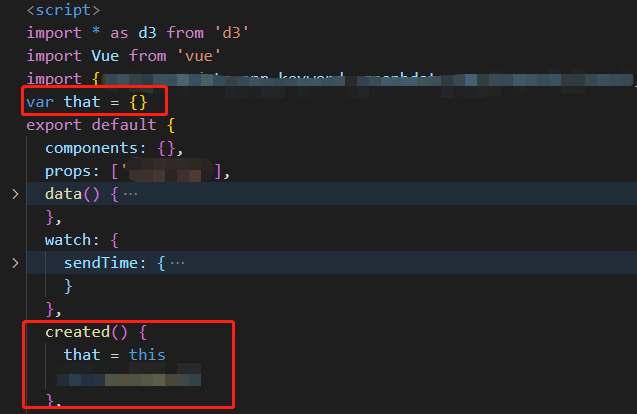0.写在前面
要实现的功能如图:

1.安装d3
npm install d3 --save-dev2.在页面中引入d3
import * as d3 from 'd3'3.在页面中增加热词tag和类名为container的div元素
<el-col :span="21" class="contans">
<div class="wordResult">
<label style="font-size:18px;">热词图谱:</label>
<ul class="ullist">
<li v-for="(item,index) in clickWord" :key="index">
<el-tag closable @close="delWord(item)">{{ item }}</el-tag><span class="listSpan" />
</li>
</ul>
<el-button type="primary" size="small" style="width:65px;height:30px;">生成结论</el-button>
</div>
<div class="container" />
</el-col>4.初始化力导向图
(1)调接口获取nodes和links后走initGraph方法
async getKeyWord(data) {
const response = await get_keyword(data)
this.testGraph['nodes'] = response.data.nodes
this.testGraph['links'] = response.data.links
this.initGraph(this.testGraph)
},(2)初始化前先清除上次的图谱 获取的数据存成全局变量
由于要注解,就不把所有代码一次性粘贴上了
如下图,在initGraph方法里,通过d3.select('#the_SVG_ID').remove() 清除上次的图谱;
由于更新图谱时需要往nodes和links数组里添加节点及联系,存成全局变量方便在其他方法里使用。这里需要引入Vue;
import Vue from 'vue'// 存入全局变量
Vue.prototype.$links = links
Vue.prototype.$nodes = nodes
// 引用全局变量
that.$links
that.$nodes下边3块代码分别是添加碰撞力和引力及控制link的长度、在container元素中创建svg元素用来放节点和连线、缩放;
这里应该会注意到 that ,这个that使用的是全局变量,因为点击node节点的箭头函数里this不生效,所以设置了that代替this:

initGraph(data) {
d3.select('#the_SVG_ID').remove()
const links = data.links.map(d => Object.create(d))
const nodes = data.nodes.map(d => Object.create(d))
Vue.prototype.$links = links
Vue.prototype.$nodes = nodes
// .distance(160)) 改变link的长度
that.simulation = d3.forceSimulation(that.$nodes)
.force('link', d3.forceLink(links).id(d => d.keyword).distance(150))
.force('collide', d3.forceCollide().radius(() => 90)) // 碰撞力
.force('charge', d3.forceManyBody().strength(-90)) // 引力
.force('center', d3.forceCenter(that.width / 2, that.height / 2));
// 创建svg元素 初始化样式
const svg = d3.select('.container')
.append('svg')
.attr('id', 'the_SVG_ID')
.attr('viewBox', [0, 0, that.width, that.height])
.style('width', 1600)
.style('height', 800)
// 缩放
svg.call(d3.zoom().on('zoom', function() {
g.attr('transform', d3.event.transform)
}))
}(3)设置箭头控制方向、svg元素中创建g元素并向其中加入svg_links和linksName
// 两个marker控制箭头方向 stroke-width 箭头粗细 refX 偏移 orient 朝向
const positiveMarker = svg.append('marker')
.attr('id', 'positiveMarker')
.attr('orient', 'auto')
.attr('stroke-width', 2)
.attr('markerUnits', 'strokeWidth')
.attr('markerUnits', 'userSpaceOnUse')
.attr('viewBox', '0 -5 10 10')
.attr('refX', 26)
.attr('refY', 0)
.attr('markerWidth', 12)
.attr('markerHeight', 12)
.append('path')
.attr('d', 'M 0 -5 L 10 0 L 0 5')
.attr('fill', '#999')
.attr('stroke-opacity', 0.6)
const negativeMarker = svg.append('marker')
.attr('id', 'negativeMarker')
.attr('orient', 'auto')
.attr('stroke-width', 2)
.attr('markerUnits', 'strokeWidth')
.attr('markerUnits', 'userSpaceOnUse')
.attr('viewBox', '0 -5 10 10')
.attr('refX', -16)
.attr('refY', 0)
.attr('markerWidth', 12)
.attr('markerHeight', 12)
.append('path')
.attr('d', 'M 10 -5 L 0 0 L 10 5')
.attr('fill', '#999')
.attr('stroke-opacity', 0.6)
// 在svg中创建g元素 将node和link放在g元素中 更精确
const g = svg.append('g')
// .attr("marker-end","url(#direction)") 添加箭头
that.svg_links = g.append('g')
.attr('stroke', '#999')
.attr('stroke-opacity', 0.6)
.attr('marker-end', 'url(#direction)')
.selectAll('path')
.data(that.$links)
.join('path')
.attr('stroke-width', d => Math.sqrt(d.value))
.attr('id', function(d) {
if (typeof (d.source) === 'object') {
return d.source.keyword + '_' + d.relationship + '_' + d.target.keyword
} else {
return d.source + '_' + d.relationship + '_' + d.target
}
})
// linksName 连线上的文字 text-anchor 锚点 startOffset 开始偏移 这两个属性实现居中
that.linksName = g.append('g')
.selectAll('text')
.data(that.$links)
.join('text')
// .attr('x', 70)
// .attr('y', 60)
.style('text-anchor', 'middle')
.style('fill', '#595959')
.style('font-size', '12px')
.style('font-weight', 'bold')
.append('textPath')
.attr(
'xlink:href', function(d) {
if (typeof (d.source) === 'object') {
return '#' + d.source.keyword + '_' + d.relationship + '_' + d.target.keyword
} else {
return '#' + d.source + '_' + d.relationship + '_' + d.target
}
}
)
.attr('startOffset', '50%')
// .attr('dx', 10)
// .attr('dy', 10)
.text(function(d) {
if (d.count) {
return '数量:' + d.count
} else {
return '数量:' + 1
}
})(4)向g元素中添加svg_nodes 点击节点时向热词列表添加热词并调接口获取该节点相关图谱
如下图:点击节点时,先判断热词列表里有没有该节点,并且group为2(评论)也不添加;
获取的新nodes和links肯定有重复的,所以需要判断是否重复;
最后添加到全局变量that.$nodes和that.$links中,并调updateGraph方法动态更新图谱
that.svg_nodes = g.append('g')
.attr('stroke', '#fff')
.attr('stroke-width', 1.5)
.selectAll('circle')
.data(that.$nodes)
.join('circle')
.attr('r', function(d) {
if (d.group === 2) {
return 25
} else {
return 20
}
})
.attr('class', 'node')
.attr('fill', that.color)
// 点击元素获取对应信息
.on('click', function(d, i) {
that.isTrue = false
that.wordData = []
that.clickWord.map((item,index) =>{
if(d.group === 2){
return
}else if(that.clickWord.indexOf(d.keyword) != -1){
return
}else{
that.clickWord.push(d.keyword)
}
})
// 根据人名d.keyword 查询到对应的link联系
const data = {
'word': d.keyword,
'start_time': that.start_time,
'end_time': that.end_time
}
get_keyword(data)
.then(function(res) {
if (res.status) {
res.data.nodes.map(item => {
let flag = true
for (var j = 0; j < that.$nodes.length; j++) {
if (that.$nodes[j].keyword === item.keyword) {
flag = false
break
}
}
if (flag) {
that.$nodes.push(item)
}
})
res.data.links.map(item1 => {
let flag = true
for (var j = 0; j < that.$links.length; j++) {
if (that.$links[j].target.keyword === item1.source === d.keyword) {
that.$links.splice(j, 1)
}
if (that.$links[j].source.keyword === item1.source) {
flag = false
break
}
}
if (flag) {
that.$links.push(item1)
}
})
that.updateGraph(d.keyword)
}
})
.catch(function(err) {
console.log(err)
})
})
.call(that.drag(that.simulation))
that.svg_nodes.append('title')
.text(function(d) {
return d.keyword
})(5)向g元素中添加节点名称nodesName 设置力图布局
设置力图布局这里就用到了两个箭头常量:#positiveMarker #negativeMarker
// nodesName title显示在node下方
that.nodesName = g.append('g')
.selectAll('text')
.data(that.$nodes)
.join('text')
.text(function(d) {
if (d.keyword.length > 2) {
return d.keyword.slice(0, 2) + '...'
} else {
return d.keyword
}
})
// .attr('dx', function() {
// return this.getBoundingClientRect().width / 2 * (-1)
// })
.attr('dx', -15)
.attr('dy', 10)
.attr('class', 'nodeName')
// 力图布局
that.simulation.on('tick', () => {
that.svg_links
.attr('d', function(d) {
if (d.source.x < d.target.x) {
return 'M' + d.source.x + ' ' + d.source.y + 'L' + d.target.x + ' ' + d.target.y
} else {
return 'M' + d.target.x + ' ' + d.target.y + 'L' + d.source.x + ' ' + d.source.y
}
})
.attr('marker-end', function(d) {
if (d.source.x < d.target.x) {
return 'url(#positiveMarker)'
} else {
return null
}
})
.attr('marker-start', function(d) {
if (d.source.x < d.target.x) {
return null
} else {
return 'url(#negativeMarker)'
}
})
that.svg_nodes
.attr('cx', d => d.x)
.attr('cy', d => d.y)
that.nodesName
.attr('x', d => d.x)
.attr('y', d => d.y)
})5.动态更新图谱方法
在点击图谱中的某个热词时,会先调接口获取与之相关的热词及联系,然后再调这个updateGraph方法
(1)遍历节点将点击节点改变填充颜色 遍历连线改变箭头方向
如下图:在这个更新图谱方法中,首先先去遍历所有节点,截取其id,判断哪个包含点击的热词,将其填充颜色改成绿色;
上步完成,就是遍历所有连线,将之前的评论与你点击的热词间的连线删掉,因为新的关系出来,连线箭头会改变
updateGraph(keyword){
var sel = d3.select(that.svg_nodes)._groups[0][0]._groups[0]
sel.map((item,index) =>{
let tempArr = []
tempArr = item.innerHTML.split('<title>')
const newStr = tempArr.join('')
let tempArr1 = []
tempArr1 = newStr.split('</title>')
const newStr1 = tempArr1.join('')
if(newStr1.length < 20 && item.__data__.group == 1){
if(newStr1.indexOf(keyword) != -1){
sel[index].style.fill = '#82E0AA'
}
}
})
that.svg_links._groups[0].map((item,index) =>{
if(item.id.slice(0,15).indexOf('app_keyword') != -1){
return
}else{
let uid = item.id.substring(item.id.length - 5)
if(uid.indexOf(keyword) != -1){
d3.select(that.svg_links._groups[0][index]).remove()
}
}
})
}(2)向初始节点数组中添加新节点 点击节点再次调用更新图谱方法
如下图:在点击节点的方法中,先遍历所有连线,判断点击的节点是否不是之前评论相连的节点,并且是新的评论相连节点
如果两个条件都满足,再做一下限制,之前点过的节点和group为2即为评论的节点都不能再点击
最后和初始化里一样,先调接口获取点击的节点相关联的热词和联系,再调updateGraph方法
that.svg_nodes = that.svg_nodes
.data(that.$nodes)
.enter()
.append('circle')
.attr('r', function(d) {
if (d.group === 2) {
return 25
} else {
return 20
}
})
.attr('fill', that.color)
.attr('class', 'node')
.merge(that.svg_nodes)
.on('click', function(d, i) {
for(var i=0;i<that.svg_links._groups[0].length;i++){
let newId = that.svg_links._groups[0][i].id.split('_fenci_')[0]
let isTrue = newId.indexOf(that.clickWord[0]) != -1
let newId1 = that.svg_links._groups[0][i].id.split('_fenci_')[1]
let isTrue1 = newId.indexOf(d.keyword) != -1
if(!isTrue && isTrue1){
that.clickWord.map((item,index) =>{
if(d.group === 2){
return
}else if(that.clickWord.indexOf(d.keyword) != -1){
return
}else{
that.clickWord.push(d.keyword)
}
})
// 根据人名d.keyword 查询到对应的link联系
const data = {
'word': d.keyword,
'start_time': that.start_time,
'end_time': that.end_time
}
get_keyword(data)
.then(function(res) {
if (res.status) {
res.data.nodes.map(item => {
let flag = true
for (var j = 0; j < that.$nodes.length; j++) {
if (that.$nodes[j].keyword === item.keyword) {
flag = false
break
}
}
if (flag) {
that.$nodes.push(item)
}
})
res.data.links.map(item1 => {
let flag = true
for (var j = 0; j < that.$links.length; j++) {
if (that.$links[j].target.keyword === item1.source === d.keyword) {
that.$links.splice(j, 1)
}
if (that.$links[j].source.keyword === item1.source) {
flag = false
break
}
}
if (flag) {
that.$links.push(item1)
}
})
that.updateGraph(d.keyword)
}
})
.catch(function(err) {
console.log(err)
})
}
}
})
.call(that.drag(that.simulation))(3)添加新节点名称、新连线、新连线名称 并重新启动simulation
that.svg_nodes.append('title')
.text(function(d) {
return d.keyword
})
// nodesName title显示在node下方
that.nodesName = that.nodesName
.data(that.$nodes)
.enter()
.append('text')
.merge(that.nodesName)
.text(function(d) {
if (d.keyword.length > 2) {
return d.keyword.slice(0, 2) + '...'
} else {
return d.keyword
}
})
.attr('dx', -10)
.attr('dy', 8)
.attr('class', 'nodeName')
that.svg_links = that.svg_links
.data(that.$links)
.enter()
.append('path')
.attr('stroke', '#999')
.attr('stroke-opacity', 0.6)
.attr('stroke-width', d => Math.sqrt(d.value))
.attr('marker-end', 'url(#direction)')
.attr('id', function(d) {
if (typeof (d.source) === 'object') {
return d.source.keyword + '_' + d.relationship + '_' + d.target.keyword
} else {
return d.source + '_' + d.relationship + '_' + d.target
}
})
.merge(that.svg_links)
// linksName 连线上文字
that.linksName = that.linksName
.data(that.$links)
.enter()
.append('text')
.style('text-anchor', 'middle')
.style('fill', 'black')
.style('font-size', '10px')
.style('font-weight', 'bold')
.append('textPath')
.attr(
'xlink:href', function(d) {
if (typeof (d.source) === 'object') {
return '#' + d.source.keyword + '_' + d.relationship + '_' + d.target.keyword
} else {
return '#' + d.source + '_' + d.relationship + '_' + d.target
}
}
)
.attr('startOffset', '50%')
.merge(that.linksName)
.text(function(d) {
if (d.count) {
return '数量:' + d.count
} else {
return '数量:' + 1
}
})
that.simulation.nodes(that.$nodes)
that.simulation.force('link').links(that.$links)
that.simulation.alpha(1).restart()6.删除选词
这里根据需求,设置的是当删除的是第一个选词的话,会清空图谱,删除其他的再去判断
如下图:在删除其他选词时,会先循环选词数组,如果删除的选词与数组的某一个相同则删除,
然后遍历links数组,如果某个连线的id前几个词包含选词数组某个词则也跟着删除;
这里的意思就是,当删除的那个词后边的词是由你删除的词散开的词,则跟着删除,否则不删
最后就是遍历选词数组剩余的词,如果是第一个还走 initGraph 方法;否则走 updateGraph 方法
// 删除选词结果
delWord(val) {
if (val == that.clickWord[0]) {
d3.select('#the_SVG_ID').remove()
that.clickWord = []
that.isTrue = false
that.wordValue = ''
that.wordData = []
that.wordFuzzyData = []
}else{
for(var i=1;i<that.clickWord.length;i++){
if(val == that.clickWord[i]){
that.clickWord.splice(i, 1)
that.svg_links._groups[0].map(item =>{
if(typeof(that.clickWord[i]) != 'undefined'){
let uid = ''
if(that.clickWord[i].length > 2){
uid = item.id.substring(0,4)
}else{
uid = item.id.substring(0,2)
}
if(uid.indexOf(that.clickWord[i]) != -1){
that.clickWord.splice(i,1)
}
}
})
}
}
}
that.clickWord.map((item,index) =>{
if(index == 0){
const data = {
'word': item,
'start_time': this.start_time,
'end_time': this.end_time
}
this.getKeyWord(data)
}
if(index != 0){
const data = {
'word': item,
'start_time': that.start_time,
'end_time': that.end_time
}
get_graphdata_app_keyword(data)
.then(function(res) {
if (res.status) {
res.data.nodes.map(item2 => {
let flag = true
for (var j = 0; j < that.$nodes.length; j++) {
if (that.$nodes[j].keyword === item2.keyword) {
flag = false
break
}
}
if (flag) {
that.$nodes.push(item2)
}
})
res.data.links.map(item3 => {
let flag = true
for (var j = 0; j < that.$links.length; j++) {
if (that.$links[j].target.keyword === item3.source === item) {
that.$links.splice(j, 1)
}
if (that.$links[j].source.keyword === item3.source) {
flag = false
break
}
}
if (flag) {
that.$links.push(item3)
}
})
that.updateGraph(item)
}
})
.catch(function(err) {
console.log(err)
})
}
})
},(本文完)
最后
以上就是无限百褶裙最近收集整理的关于52.在vue中使用d3创建力导向图并动态新增、删除节点及联系的全部内容,更多相关52内容请搜索靠谱客的其他文章。








发表评论 取消回复